4-out 1-in motion (Bauer)
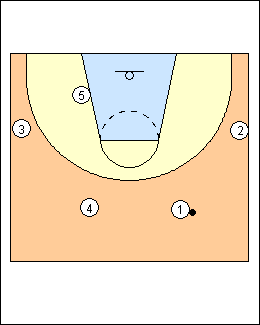 | 1 Jeff Bauer Spacing is offence. To pull the defence out and up, keep perimeter players on the NBA 3-point arc and above a "spacing line" just below the foul line. Fill both wing and both swing spots. After screens and cuts, space out then space up. Ball reversal is the best way to break down the defence, rarely attack the first side of the possession. The best time to attack is on a skip pass. In addition to overhead (skip) passes, use flick (outside hand) passes, and two-inch ball fakes (pass and shot fakes). Receivers catch with both feet in the air and jump stop facing the basket - square in the air. Hold the ball for a two-count, looking for a shot, open post player or cutter, drive, or skip pass. Dribble penetration is the hardest action to defend, but never take more than 2-3 dribbles when the ball is in scoring area. Also use the dribble to feed the post (from below the spacing line), shorten a pass to the other side of the floor, and dribble loop against a team that denies entry passes. |
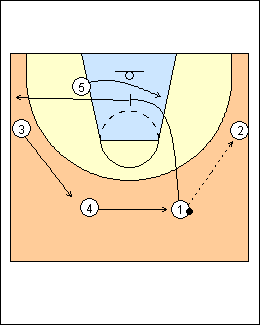 | 2 Away from the ball, "stay for two, then someplace new". Basket cutting is the foundation of motion offence. Make a speed cut, don't take a step away and give your defender time to recover. Finish all cuts at the basket, then space out and up, backscreen for a perimeter player, or cross-screen for the post (shown). Backcut when overplayed, take a step towards the ball, show a fist to the passer, push off the top foot. There should be a mix of cuts and screens. Perimeter players are defined as screeners and cutters. Cutters are better finishers and scorers, although screeners can be good catch and shoot players. Screening rules are: - screeners can screen for cutters - cutters can screen for cutters - cutters can screen for the post - the post can screen for anyone. However, a cutter who is a good shooter could be allowed to backscreen for any player. |
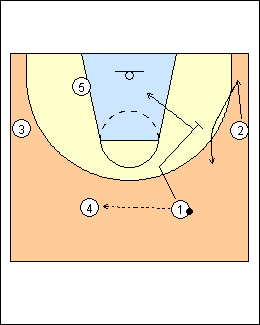 | 3 In general, a screener makes a two-step speed cut to the basket, then head hunts a defender and jump stops wide and low, wrapping his shooting wrist with the other hand. After xcutter has fought through the screen, the screener must second cut (out cut) beyond the arc or to the extent of his shooting range, with ready hands. If xscreener gives excessive help or communicates a switch, the screener should slip to the rim (shown) or to the ball, then space out and up. The cutter continues his primary cut unless it interferes with the slip. The cutter waits for the screen, sets up the cut, cuts at the screener, comes off the screen shoulder to hip with ready hands but reading the defence, not watching the ball (play tag with the defender). If xcutter goes ballside of the screen, the screener changes the screen angle to pin the defender in the lane, the cutter stops his cut, pushes off the screener's back, and fades to an open area. The passer shortens the pass with one dribble (take the ball to the screen). |
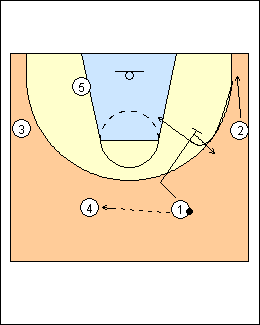 | 4 There are three basic screens - downscreen, flare screen, rear screen. a) Downscreen - The proper screen angle is back to the ball. The cutter waits for the screen, sets up the cut by taking two slide steps along the arc away from the oncoming screen (drag the arc), then cuts directly at the screener (nose to nose), comes off shoulder to hip while reading the defence. If xcutter goes manside of the screen, the cutter curl cuts to the basket, wrapping his inside arm around the screener, then the screener out cuts to the swing spot (reverse pivot outside foot). If xcutter goes ballside of the screen, the screener changes his angle to pin the defender (forward pivot baseline foot, back to the sideline), the cutter touches the screener's back and cuts to an open area (fade cut). While the primary cut is to curl, or semi-curl to the foul line area if the lane is congested, the cutter will backcut if his defender jumps on the line of the cut to prevent the cutter from reaching the screen. |
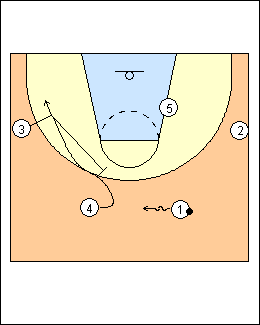 | 5 b) Flare screen A reliable way to swing the ball, tough to guard because xcutter goes from a deny or gap position to chasing an attacker going away, tough to hedge because the screener sees the defence and can slip directly to the basket if his defender gives excessive help (weakside of the screen) or switches. The proper screen angle is back to the corner. The cutter walks his man towards the ball, pushes off his ballside foot, runs directly at the screener, brushes by the outside hip, and sprints to the corner (don't shuffle or slide past the screen). The ballhandler shortens the pass with one dribble or by dribbling to the swing spot. If xcutter goes manside and the post is on the other side of the floor, the cutter can curl to the basket. If xcutter goes ballside, the screener changes his angle to downscreen (re-screen). |
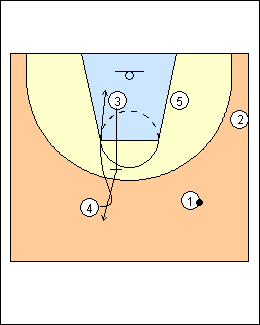 | 6 c) Rear screen The most difficult screen to defend because the cutter is going directly to the basket. The proper screen angle is back to the basket. The cutter sets up his man by walking him up higher and towards the ball (same as a flare screen), breaks to the weakside hip of the screener, finishes his cut at the rim. The screener out cuts, and is usually open because his defender must help. If xcutter goes ballside, the screener changes his angle to pinscreen, the cutter stops his cut and fades behind the screen or to an open area, the dribbler shortens the pass. Many defences switch rear screens, so slipping is also very effective. The cutter goes to the rim, the screener cuts back to the ball or to an open area. |
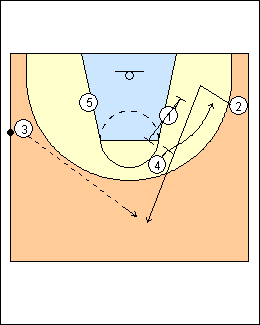 | 7 To create opportunities for scorers, - use big-little screens - consecutive cuts, two players use the same screen in succession - drive to the side of a shooter - other players screen only for the hot shooter - a shooter enters the ball into the post if his defender will double down or dig, or to cut off the post - a non-shooter makes a post-entry pass and upscreens for a shooter - shooters set rearscreens - take and return - enter the ball to the side of a shooter, swing the ball, then bring it back to the shooter using screens - a shooter sets one or two screens before he gets a screen - screen and re-screen for a shooter (e.g., downscreen, flarescreen) - screen-the-screener action, e.g., triangle - side-by-side (double) screens - staggered screens, then the bottom screener should flarescreen for the top screener (shown). |
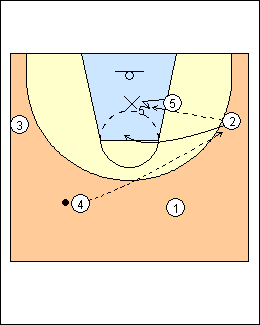 | Post play Bigs try to seal their defender, don't run to the block or the ball (allow one or two flashes per possession). Cut directly at the defender and get into his legs. Before getting a pass, bigs get their feet wet inside the paint. Anytime the ball is on or moving to his side of the floor, the big should step into his defender and seal him in the paint (leg whip or pin and spin). If fronted, the big can set up for a lob, shoulders parallel to and facing the baseline. On a pass into the post from the wing, the passer should then a) cut through the elbow area if xpasser relaxes (shown), b) v-cut and go baseline if xpasser plays the elbow cut, c) relocate along the arc if xpasser doubles down, or d) upscreen for a shooter. Rick Majerus - cut against the swing of the head, if the post feeder’s defender turns his head to the middle, the post feeder makes a baseline cut, if the defender turns his head baseline, the post feeder makes a middle cut or performs a split or a screening action with the nearest perimeter. The top must be squared on all post catches (fill the slots). On any baseline power move that the post makes, the ballside corner must be filled for a bailout option, the post feeder slides baseline and the ballside slots slides to the wing spot he vacated, or the post feeder screens for the slot who slides to the corner (to break a switch, the screener or cutter can dive). Ken Atkins - if the passer cuts baseline or middle to the hoop (ending at the weakside block), the nearest perimeter player replaces him. On a split, the passer screens for the closest perimeter player, switching positions. Another option is that the other big cuts to the weakside block, other players spot up on the ballside wing/corner, above the ballside elbow, and to the weakside elbow. John David Jackson (FIBA Assist issue 43) - if you have an undersized big, teach him how to make a dribble-out hand-off. On a post catch, he has a couple of seconds to decide whether to go one-on-one, during this time his teammates have initiated their movements, which should always have a strong-side pass solution. If he decides on a hand-off, he should dribble out towards the three-point line almost to the foul-line extended, pivot, hand off, and roll to the lane. If X5 doesn't help on the hand-off, the ballhandler will have an excellent chance to attack the open baseline if his man followed over the hand-off, or shoot a pull-up jumper if his man went under. If X5 helps on the hand-off (more likely), the ball should be dropped off to the rolling big man. Weakside teammates should be available for a skip pass. |
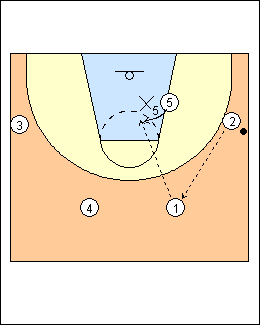 | 9 With the ball in the middle third of the floor, the big looks to muscle cut [duck in] unless his defender is sealed out of the lane. This is particularly effective if the defender is not playing up the line. If 4 cross-screens off a quick reversal to 3, 5 should front pivot on his outside (left) foot and go under the cross screen. |
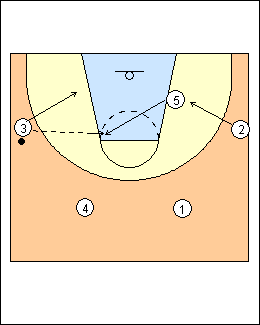 | 10 Weakside post play is a great time to screen, v-cut, or wait for a skip pass. Although a flash to the ball at the high post is basic, this should be the least-used option on the weakside - don't chase the ball (unless the big is dominant). |
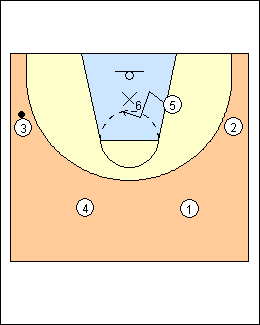 | 11 Use v-cutting to seal a defender, not to run to the opposite lane line. If the defender is lower, jog him one step lower, change speed and direction 90 degrees to get your top foot just past the defender, push off the top foot and swing the bottom leg over top and in front, sit on the defender's legs, and keep the defender sealed using six-inch slide steps in a half-moon shape. If the defender is level or higher, take him higher then cut 90 degrees to seal him from the baseline side. |
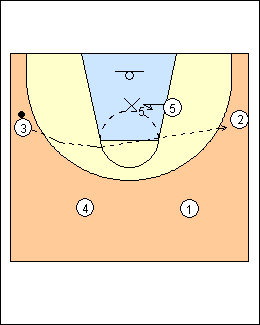 | 12 Waiting for a skip pass allows the big to get a post feed off quick ball reversal, stepping into the defender deep in the paint as the pass is in the air. If a shot is taken from the other side of the floor, explode into the defender to trap him under the rim. Most rebounds come out weakside on the same angle as the shot at about half the distance. |
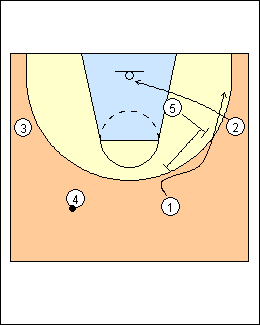 | 13 Bigs are good screeners. The rear screen is the most basic and efficient screen out of the post since the angle is already set and the screen can be set quickly. The best rear screen is for a player who is overplayed or has just passed the ball. An effective movement is to rear screen then immediately flare screen, the two hardest screens to defend set by the best screener. After setting the flare screen 5 can dive into the post or out cut for a shot or ball reversal. (Jamie Dixon - 4 brings it on the dribble, 3 and 2 fill behind, 5 posts up). Post flare screens are a great way to feed the post, if X5 stays in the paint, 5 should sprint into the paint and seal for a post feed from 1. If X5 helps on the flare, 5 may seal him out. The post looks to pinscreen on the lane line any weakside defender who is in or near the paint. If the defender fights over the screen on a skip pass, the post releases and seals his own man in the paint; if the defender goes low, the post should set an incidental screen by rolling low as if posting up. The post also looks to screen then re-screen for a teammate, e.g., rear/down, flare/down. |
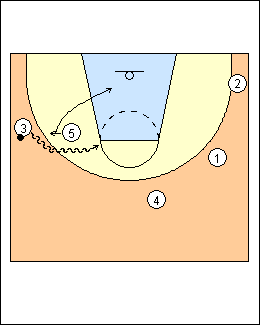 | 14 Also use the big to set ballscreens, although never ballscreen on the first side of the possession (or going to the baseline). The ballhandler fakes baseline. Options for the screener are a) slip to the basket if there is a trap, excessive hedge, or xdribbler goes under the screen b) pop for a shot, swing or hi-lo feed c) cut off a flare or rear screen for an isolation d) re-screen for the ball. If the screen defender switches or hedges, the first option is for the ballhandler to attack the top shoulder of the screen defender, try to get into the paint, and take at least two dribbles to create a passing lane to the screener. The screener can roll the perimeter defender on his back. The second option against a heavy hedge or switch is for the screener to slip to the basket, creating an angle for the dribbler to penetrate the middle (shown). |
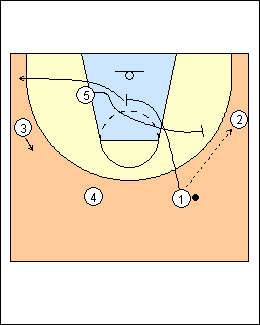 | 15 If the defence traps a ballscreen, attack, and look to the other side of the floor. The screener looks to slip to the basket or the corner (a safety valve). Against a team that goes under the ballscreen, have the screener roll the defender on his back, or set a double (side by side) or staggered ballscreen. A post player should be the last screener in a staggered screen to prevent switching. If the on-ball defender jumps high side to force baseline, the dribbler can make a quick cross-over move to attack baseline. The screener should set the screen higher than normal. If xscreener is good at defending ballscreens, screen for the screener before he comes to screen, then the perimeter player spaces out weakside (shown) or rear screens for the post after the ballscreen. |
This page was made with Basketball playbook from Jes-Soft